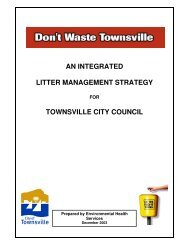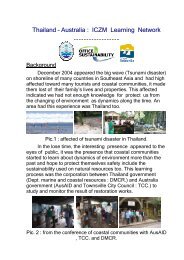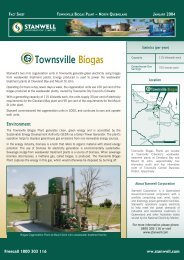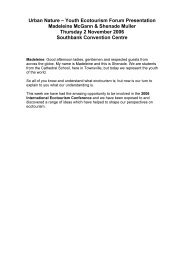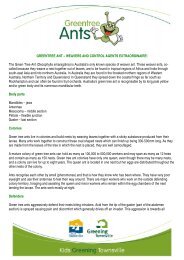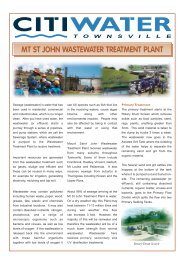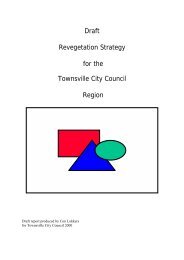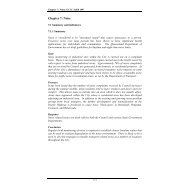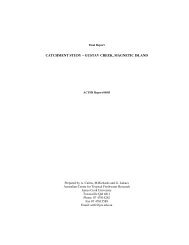ENVI RONMENTAL HI STORY OF ROWES BAY - Townsville State ...
ENVI RONMENTAL HI STORY OF ROWES BAY - Townsville State ...
ENVI RONMENTAL HI STORY OF ROWES BAY - Townsville State ...
- No tags were found...
You also want an ePaper? Increase the reach of your titles
YUMPU automatically turns print PDFs into web optimized ePapers that Google loves.
Environmental history of Rowes BayAPPENDIX 1Environmental changes along Rowes Bay foreshore, 1864-2000.1864 <strong>Townsville</strong> established in November.1867 8 th March - first cyclone hits settlement. Probable beach erosion.1870 20 th February - cyclone demolishes most of the town. Probable beach erosion.1874 17 th February - cyclone damages much of <strong>Townsville</strong>. Probable beach erosion.1874 First breakwater constructed at <strong>Townsville</strong> Port. The construction of this ~120 mlong causeway between Ross Island and Magazine Island marked the beginning ofthe end of the natural supply of sand from Ross River to the Strand and Rowes Baybeaches. The <strong>Townsville</strong> Portmaster commented: "Through this opening a constantsupply of sand from Ross River had previously poured into the entrance of (RossCreek) forming a series of bars and shoals. This movement of sand has been entirelyarrested by the breakwater."Breakwater on the north side of Ross Creek also constructed ("Fountains Folly"),extending ~400 m out into Cleveland Bay.1876-1889 Construction of Eastern Breakwater at Port which eventually extends ~850 m outinto Cleveland Bay. Wave action would be unlikely to be able to transport sand fromRoss River mouth around this obstruction.1884 First dredging of Platypus Channel. Any sand from Ross River mouth reaching theend of the breakwater would be intercepted by this dredging.1886 Hydrographic chart shows a sand spit at the mouth of Mundy Creek. It is ~250 mlong and deflects the stream mouth to the NW to the area of the present toilet blocks.Bar morphologies are shown offshore from Kissing Point, interpreted as sand beingtransported from the Strand around into Rowes Bay.1891 Western Breakwater at Port completed.1892 24 th January – 488 mm rainfall event in 24 hours. Some beach erosion may haveoccurred.1896 26-27 th January - Cyclone Sigma causes damage over a wide area. Probable beacherosion.1903 9 th March Cyclone - Leonta severely damages <strong>Townsville</strong>. Probable beach erosion.28 th December – 381 mm of rain fell in 24 hours. This may also have caused somebeach erosion.1908-1943 Construction of weirs on Ross River. Gleeson's Weir (1908), 14.8 km from mouth.Aplin's Weir (1928), 10.5 km from mouth. Blacks Weir (1934), 16 km from mouth.Aplins Weir rebuilt (1943). Since 1908, the natural supply of sand to the mouth ofRoss River has been restricted to the lower ~15 km of channel, and since 1928further restricted to the lower 10.5km of channel. However, since 1875 any sanddelivered to the mouth was being trapped to the east of the Port breakwaters.1910-1934 Four weak tropical cyclones (1910, 1916, 1929, 1934) pass within ~50 km of<strong>Townsville</strong>. Some beach erosion may have occurred.Early 1930s Heatley's Parade road to Three Mile Creek constructed, and the fig trees (visible ofthe 1938 aerial photographs) along the seaward side of this were probably plantedsoon after. The Three Mile Creek bridge and road to Pallarenda were completed bythe mid 1930s.1938 5 th July - aerial photographs. These are the earliest known vertical aerial photographsof <strong>Townsville</strong>, and they show that development of North Ward and Belgian Gardenssuburbs was underway, and the original vegetation communities were largely gone.19



